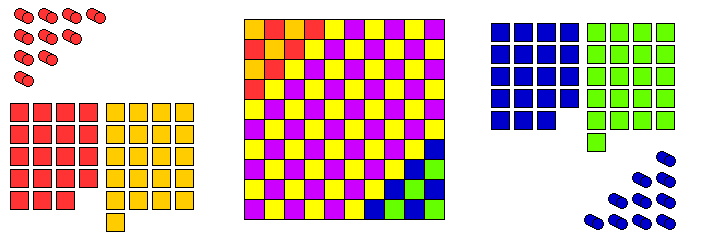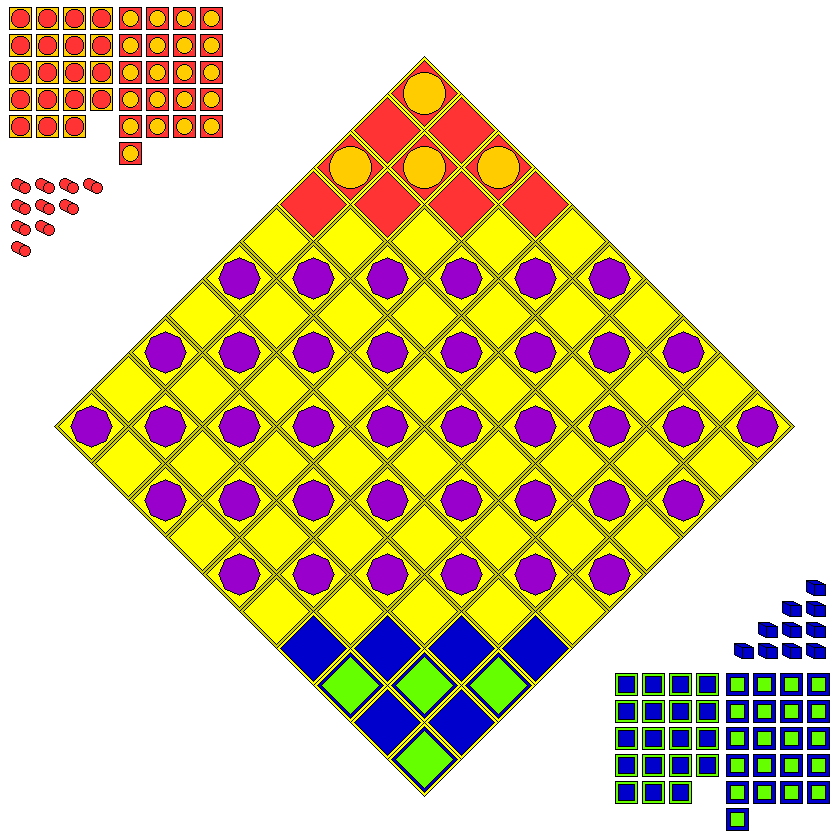
The diagram below illustrates the equipment for a board game that, like Chess or Checkers, depends on skill alone, which I have devised to meet a number of requirements:

The styling of the squares and the tiles could be made somewhat fancier, though, so as to avoid issues for color-blind individuals (someone else identified the concern, but I alone am to blame for the garish solution):

These requirements were:
These goals had been on my mind for some time, but I could not think of a way, until just now with this game, to devise a game that met them. However, although I am confident that it meets the goals I had set for myself, I suspect that one other characteristic of the game is such as to prevent it from having any chance of achieving wide popularity.
I have just come across this game, which is played with an ordinary chess set, but which is designed to achieve another goal I had in the design of this game, which I did not explicitly mention above: for the game to be relatively easier for people and relatively harder for computers. The reason I did not mention that goal is because it has already been achieved to an extent by Go, and this game (that is, my game described on this page, not the one linked to in this paragraph) incorporates elements of Go.
The actual play of the game is simple enough, being very similar to that of Halma or Chinese Checkers. The game is played on a 10 by 10 board. There are two sides to the game, Red and Blue, each with ten pieces, which start in opposite corners of the board.
In the picture of the board above, the Red pieces start in the squares shown as red and orange, and the Blue pieces start in the squares shown as blue and green.
The object of the game is to be the first to move all of one's men into the ten spaces from which one's opponent has started.
Each turn, each side moves one of its men. That man may either be moved one space orthogonally, or may jump diagonally over one or more men of either side.
Under some circumstances, to be described after the initial phase of the game is explained, a man of the opposing side that is jumped over is captured. However, a captured piece is returned to the opponent, who must then re-enter it on the board in one of his ten starting squares on the next turn, unless all those squares are occupied, in which case he must move one of his men that are on his starting squares out of those squares.
This may be thought of as somewhat analogous to the fate of pieces captured in Backgammon.
In Nine Men's Morris, first the players place their men one by one on the board, and then they move their men alternately.
This game also has two parts. The board consists of 100 squares in a 10 by 10 array. Each player has a starting area of 10 squares which are chequered in that player's own pair of colors: red and orange for the Red player, blue and green for the Blue player. The remaining 80 squares of the board are chequered in neutral colors, purple and yellow.
The Red player has 40 tiles, 19 red and 21 orange, and the Blue player has 40 tiles, 19 blue and 21 green.
The red and blue tiles are purple on the reverse side, and the orange and green tiles are yellow on the reverse side.
In the beginning portion of the game, the players alternately place one tile at a time on the neutral squares of the board. Red and blue tiles may only be placed on purple squares, orange and green tiles may only be placed on yellow squares.
If a connected (in the orthogonal directions) group of tiles of one player's color become completely surrounded (again, in orthogonal directions) by tiles of the opposing player's colors, as the result of a move by the opposing player, they are flipped over to their neutral-colored side. Note that they are not removed from the board, and no tiles may be placed on the squares where they remain located. Also, note that contact with the ten squares of one's own starting area (which, being printed on the board, are not subject to changing in color, at least as long as the ink doesn't fade) is sufficient to protect tiles from being flipped.
This, of course, closely resembles the rules of the game of Wei Ch'i or Go, but the subtle differences in the rules will make a great difference in the strategy. Particularly, the fact that one can remove the last connection of a group of one's own tiles from a neutral space without them being flipped is a large difference.
Rather than attempting to determine the winner of the game by counting how much territory one has acquired in that phase, the advantage of controlling more territory lies in how it affects the play of the main phase of the game.
If a Blue piece jumps over a Red man on a red or orange square, that man is not affected by being jumped over, the same as a Blue man that the Blue piece jumps over. This also applies when a Red piece jumps over a Blue man on a blue or green square.
On other squares, jumping over one of the opponent's men does capture that man. In the case of an opponent's man on a square of a neutral color, purple or yellow, if a capture is available, a capturing move must be made, and a series of jumps may not end when there is an opposing man on a neutral color square that could be jumped over and captured.
When the opposing man is on a square of one of one's own two colors, however, jumping over that man to capture it is strictly optional, as in Chess.
The last player to lay a tile is also the first player to move a man. The right to lay the first tile alternates between the Red and Blue players, rather than having the board be turned around.
These are the rules of the game. While the rules seem simple enough to learn, and the board is nice and colorful for a good reason... it seems to me that the flaw is this: the initial phase of the game is likely to be perceived as too much effort for too little reward. Playing a profound game like Go in order to set things up to play a trivial game like Chinese Checkers could well be perceived as perverse. Thus, while the effects of the preliminary phase, by making the board significantly different for every game, would seem to achieve the desirable goal of making the strategy for each game potentially profound, I fear that more work still needs to be done at the drawing-board.